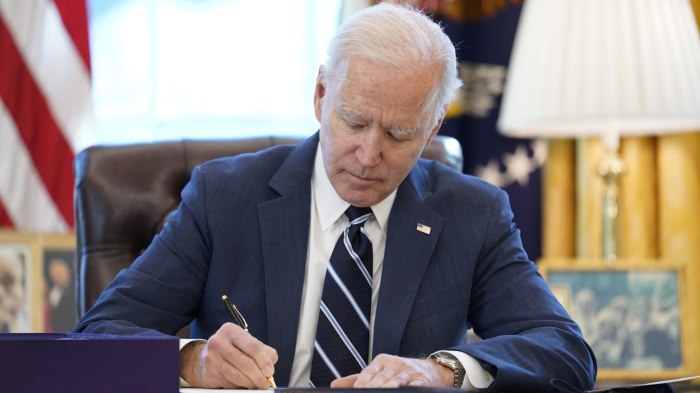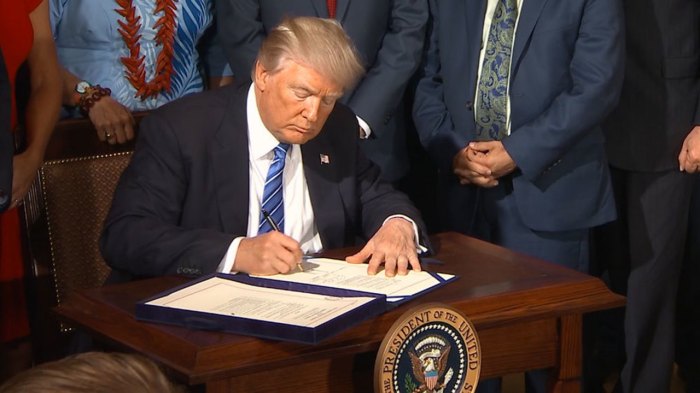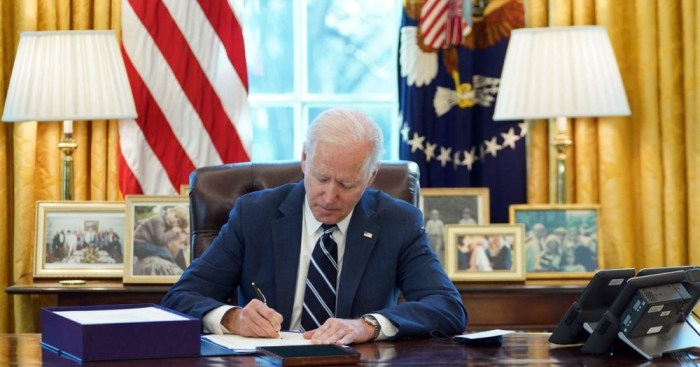
Who signs a bill into a law – Who signs a bill into law? The answer, in the United States, is the President. This seemingly simple question delves into the heart of American democracy, revealing a complex interplay between the legislative and executive branches. From the drafting of a bill to its eventual enactment, the President holds a pivotal role in shaping the nation’s laws.
The process begins in Congress, where bills are introduced, debated, and amended. Once a bill is passed by both the House of Representatives and the Senate, it is sent to the President’s desk for approval. The President has the power to sign the bill into law, effectively giving it the force of law, or to veto it, sending it back to Congress for reconsideration.
The Presidential Role in Lawmaking: Who Signs A Bill Into A Law

The President of the United States plays a crucial role in the legislative process, possessing the power to sign bills into law or veto them. This power is enshrined in the Constitution and represents a vital check on the legislative branch. Understanding the President’s role in lawmaking requires examining the process by which bills reach their desk, the options available to the President, and the historical and legal significance of their actions.
The Journey of a Bill to the President
Before a bill can reach the President’s desk for signature, it must undergo a rigorous legislative process in Congress. This process begins with the introduction of a bill in either the House of Representatives or the Senate. Once introduced, the bill is referred to the relevant committee for review and potential amendments. If the committee approves the bill, it is then sent to the floor of the House or Senate for debate and a vote.
If a bill passes both chambers of Congress in identical form, it is sent to the President for consideration. The President has ten days (excluding Sundays) to review the bill and decide whether to sign it into law or veto it. If the President does not take action within ten days, the bill automatically becomes law, unless Congress adjourns before the ten-day period, in which case the bill is automatically vetoed.
Presidential Options: Signing, Veto, or No Action
The President has three options when a bill reaches their desk:
- Sign the Bill: This is the most common action, and it signifies the President’s approval of the bill. Once signed, the bill becomes law.
- Veto the Bill: The President can reject a bill by issuing a veto. This action prevents the bill from becoming law unless Congress overrides the veto with a two-thirds majority vote in both chambers.
- Take No Action: If the President does not sign or veto a bill within ten days, the bill automatically becomes law, unless Congress adjourns before the ten-day period, in which case the bill is automatically vetoed. This is known as a “pocket veto.”
Historical Significance of Signing Ceremonies
Presidential signing ceremonies have become a tradition in American politics, often symbolizing the culmination of a lengthy legislative process. These ceremonies, often held in the Oval Office or the White House Rose Garden, are televised and attended by lawmakers, dignitaries, and members of the public. They provide a platform for the President to highlight the importance of the legislation and to engage in public discourse on its implications.
Legal and Political Implications of a Presidential Veto
A presidential veto is a powerful tool that allows the President to check the legislative power of Congress. The Constitution grants the President the power to veto legislation, but Congress can override a veto with a two-thirds majority vote in both chambers. The veto power is a critical element of the system of checks and balances, ensuring that no single branch of government becomes too powerful.
A presidential veto can have significant political implications, as it often signals a disagreement between the President and Congress on a particular policy issue. Vetoes can also be used as a bargaining chip in negotiations between the President and Congress, as the threat of a veto can incentivize lawmakers to compromise.
“The veto power, as a check upon the legislative branch, is an essential part of our constitutional system. It serves to protect the people from hasty or ill-considered legislation, and to prevent the enactment of laws that are not in the best interests of the nation.” – President Dwight D. Eisenhower
The Legislative Process and Bill Passage

The journey of a bill from its initial conception to becoming a law is a complex and multifaceted process that involves numerous stages, key players, and intricate procedures. This process is designed to ensure that laws are carefully considered, debated, and ultimately reflect the will of the people.
The Journey of a Bill Through Congress
The legislative process begins when a bill is introduced in either the House of Representatives or the Senate. Once a bill is introduced, it is assigned to a relevant committee for review and consideration. Committees play a crucial role in shaping legislation by holding hearings, conducting research, and amending bills before they are sent to the full House or Senate for debate and a vote.
Key Players in the Legislative Process
- Members of Congress: Both the House of Representatives and the Senate have members who represent different districts or states. They introduce bills, debate legislation, and vote on bills that reach the floor.
- Committees and Subcommittees: Committees and subcommittees are responsible for reviewing and amending bills before they are sent to the full House or Senate. They hold hearings, invite expert testimony, and conduct research to inform their decisions.
- The President: The President has the power to sign bills into law or veto them. If a bill is vetoed, Congress can override the veto with a two-thirds majority vote in both houses.
- Lobbyists: Lobbyists are individuals or groups who try to influence the legislative process on behalf of their clients. They may provide information to lawmakers, organize public demonstrations, or contribute to political campaigns.
The Role of Committees and Subcommittees, Who signs a bill into a law
Committees and subcommittees play a vital role in shaping legislation by providing a forum for expert testimony, conducting research, and amending bills. They are responsible for reviewing bills and making recommendations to the full House or Senate.
- Hearings: Committees hold hearings to gather information and hear from experts on a particular issue. These hearings can be open to the public or closed to the public, depending on the nature of the issue.
- Markups: Once a bill has been reviewed by a committee, it may be marked up, which means that amendments are made to the bill. These amendments can be proposed by committee members or by other members of Congress.
- Reports: After a committee has completed its review of a bill, it may issue a report that summarizes the bill and its recommendations. This report is often used by members of Congress to inform their decisions on whether to support or oppose the bill.
Amending and Voting on Bills
Once a bill has been reviewed by a committee, it is sent to the floor of the House or Senate for debate and a vote. During debate, members of Congress can propose amendments to the bill. If an amendment is approved, it becomes part of the bill.
- Amendments: Amendments are changes made to a bill during the legislative process. They can be proposed by members of Congress, committees, or the public.
- Floor Debate: Once a bill is on the floor, members of Congress can debate the bill and propose amendments. The debate can be limited or unlimited, depending on the rules of the House or Senate.
- Voting: After debate, a vote is taken on the bill. In the House, bills are voted on by voice vote, division vote, or recorded vote. In the Senate, bills are voted on by voice vote, roll call vote, or recorded vote.
Passage of a Bill
If a bill is approved by both the House and the Senate, it is sent to the President for their signature. If the President signs the bill, it becomes law. However, the President also has the power to veto a bill. If a bill is vetoed, Congress can override the veto with a two-thirds majority vote in both houses.
The Impact of Law Signing on Society
The signing of a bill into law marks a pivotal moment in the legislative process, signifying the official adoption of a new policy or regulation. This act carries significant implications for society, both immediate and long-term, influencing the lives of individuals, businesses, and the nation as a whole.
The Immediate Impact of Law Signing
The immediate impact of a law signing is often felt in the form of changes to existing rules, regulations, and practices. For example, a law that increases the minimum wage will immediately affect the earnings of low-wage workers, while a law that restricts the use of certain chemicals will immediately impact businesses that rely on those chemicals.
The Long-Term Impact of Law Signing
The long-term impact of law signing is often more complex and multifaceted, influencing social, economic, and political dynamics over time. For instance, a law that provides tax incentives for renewable energy investments can lead to a long-term shift towards a more sustainable energy sector. Similarly, a law that expands access to healthcare can have a long-term impact on public health outcomes.
The Impact of Law Signing on Various Stakeholders
The impact of a new law can vary significantly depending on the stakeholder group. For example, a law that regulates pollution could benefit environmental groups but impose costs on businesses that generate pollution. A law that provides tax breaks for families with children could benefit families but increase the national debt.
Hypothetical Scenario: The Impact of a New Law on Small Businesses
Consider a hypothetical scenario where a new law requires all businesses to adopt a specific type of energy-efficient technology. While this law could promote environmental sustainability in the long run, it could also impose significant costs on small businesses, especially those with limited resources. These businesses might have to invest in new equipment, hire skilled technicians, or adjust their operations, potentially leading to reduced profits or even closure.
Potential Benefits and Drawbacks of a Specific Law
The following table Artikels the potential benefits and drawbacks of a law that increases the minimum wage:
| Benefits | Drawbacks |
|—|—|
| Increased income for low-wage workers | Potential job losses as businesses adjust to higher labor costs |
| Reduced poverty and inequality | Increased prices for goods and services as businesses pass on higher costs |
| Increased consumer spending | Decreased profits for businesses |
| Improved morale and productivity among workers | Potential strain on government budgets if businesses reduce their tax contributions |
End of Discussion

The President’s signature is more than just a formality; it symbolizes the culmination of a long and intricate process. It represents the President’s approval of the law and its potential impact on the nation. Understanding the President’s role in lawmaking is crucial to comprehending the balance of power in the American government and the intricate dance between legislation and executive authority.
Questions and Answers
What happens if the President doesn’t sign a bill?
If the President does not sign a bill within ten days of receiving it (excluding Sundays), the bill automatically becomes law without their signature. This is known as a “pocket veto.” However, if Congress adjourns before the ten-day period expires, the bill is automatically vetoed.
What are the legal and political implications of a presidential veto?
A presidential veto is a powerful tool that allows the President to block legislation they deem inappropriate. It can have significant political implications, often leading to heated debates and negotiations between the President and Congress. Congress can override a presidential veto with a two-thirds majority vote in both houses.




